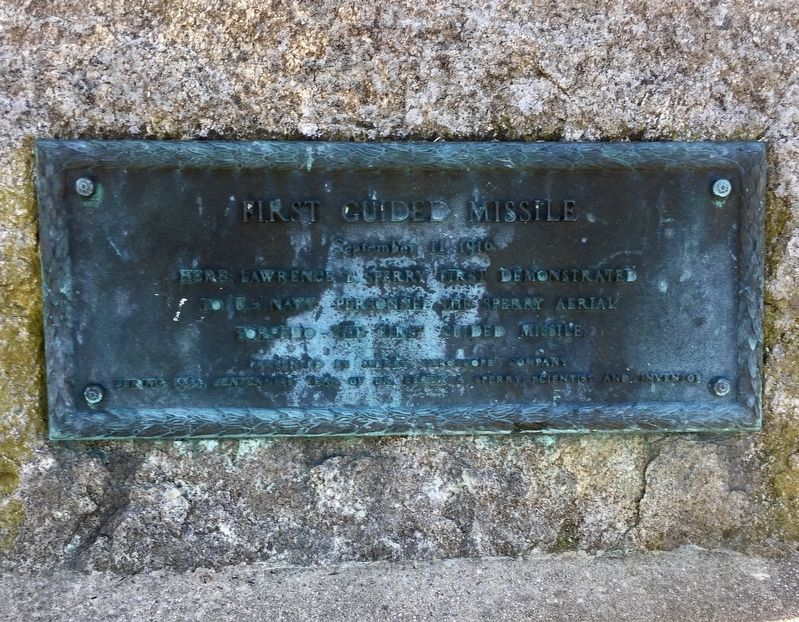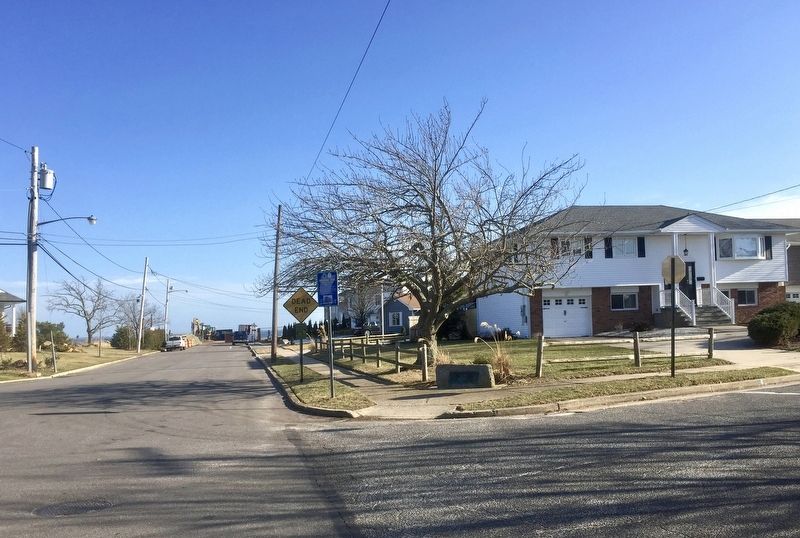First Guided Missile
First Guided Missile
September 11, 1916
Here Lawrence B. Sperry first demonstrated to the U.S. Navy the Perry Aerial Torpedo - the first guided missile.
Presented by Sperry Gyroscope Company during 1960, centennial year of Dr. Elmer A. Sperry, scientist and inventor
Erected 1960 by Sperry Gyroscope Company.
Topics. This historical marker is listed in this topic list: Air & Space. A significant historical date for this entry is September 11, 1916.
Location. 40° 39.467′ N, 73° 24.915′ W. Marker is in Amityville, New York, in Suffolk County. Marker is at the intersection of Richmond Avenue and Unqua Place, on the right when traveling south on Richmond Avenue. Touch for map. Marker is in this post office area: Amityville NY 11701, United States of America. Touch for directions.
Other nearby markers. At least 8 other markers are within 2 miles of this marker, measured as the crow flies. Cross-Island Trolley (here, next to this marker); Ireland's Mill (approx. 0.9 miles away); Walt Whitman (approx. 1.1 miles away); Naomi W. Griffiths (approx. 1.3 miles away); Former High School (approx. 1.3 miles away); St. Mary's Church (approx. 1.3 miles away); Suffolk County (approx. 1.4 miles away); Thorn Estate (approx. 1˝ miles away). Touch for a list and map of all markers in Amityville.
Also see . . .
1. Hewitt-Sperry Automatic Airplane (Wikipedia). "The Hewitt-Sperry Automatic Airplane was a project undertaken during World War I to develop an aerial torpedo, also called a flying bomb or pilotless aircraft, capable of carrying explosives to its target. It is considered by some to be a precursor of the cruise missile....The first test flights of an autopilot-equipped aircraft was in September, 1917, and took place with a human pilot on board to fly the takeoff. By November, the system successfully flew the aircraft to its intended target at a 30-mile (48 km) range, where the distance-measuring gear would drop a bag of sand. Accuracy was within two miles (3 km) of target." (Submitted on March 10, 2018.)
2. Curtiss-Sperry Aerial Torpedo (Cradle of Aviation Museum). "The Sperry Aerial Torpedo tests were the first guided missile program in this country. In 1916, Lawrence Sperry, developer of the autopilot, formed a new company and set up flying operations at an isolated site at Amityville on the Great South Bay. Here, the Navy funded the development of unmanned flying bombs intended to be launched against military targets. Five "Aerial Torpedoes" were then built by the nearby Curtiss Company. A special track and dolly was developed and Aerial Torpedoes were launched by this system with some success.
Credits. This page was last revised on March 10, 2018. It was originally submitted on March 10, 2018, by Andrew Ruppenstein of Lamorinda, California. This page has been viewed 687 times since then and 61 times this year. Photos: 1, 2. submitted on March 10, 2018, by Andrew Ruppenstein of Lamorinda, California.

